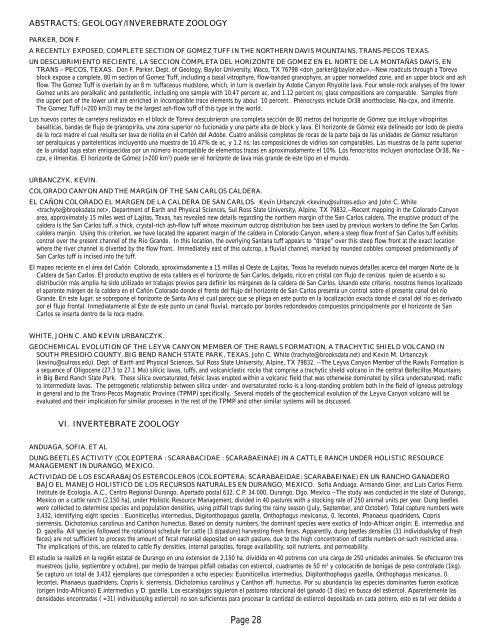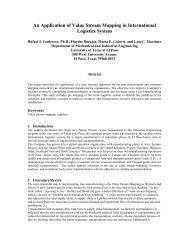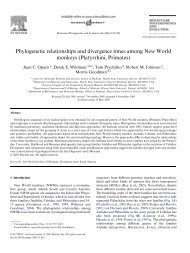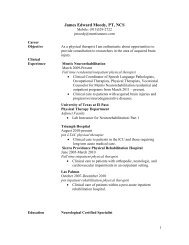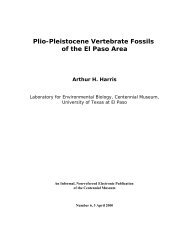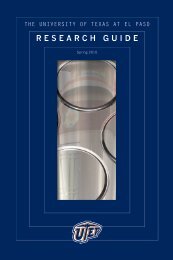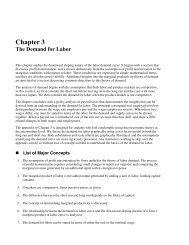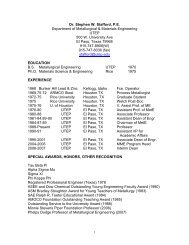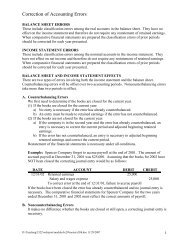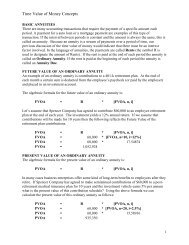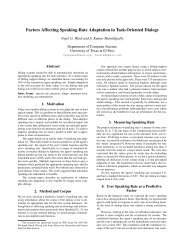Sym - Abstracts - University of Texas at El Paso
Sym - Abstracts - University of Texas at El Paso
Sym - Abstracts - University of Texas at El Paso
Create successful ePaper yourself
Turn your PDF publications into a flip-book with our unique Google optimized e-Paper software.
ABSTRACTS: GEOLOGY/INVEREBRATE ZOOLOGY<br />
PARKER, DON F.<br />
A RECENTLY EXPOSED, COMPLETE SECTION OF GOMEZ TUFF IN THE NORTHERN DAVIS MOUNTAINS, TRANS-PECOS TEXAS.<br />
UN DESCUBRIMIENTO RECIENTE, LA SECCION COMPLETA DEL HORIZONTE DE GOMEZ EN EL NORTE DE LA MONTAÑAS DAVIS, EN<br />
TRANS – PECOS, TEXAS. Don F. Parker, Dept. <strong>of</strong> Geology, Baylor <strong>University</strong>, Waco, TX 76798 .--New roadcuts through a Toreva<br />
block expose a complete, 80 m section <strong>of</strong> Gomez Tuff, including a basal vitrophyre, flow-banded granophyre, an upper nonwelded zone, and an upper block and ash<br />
flow. The Gomez Tuff is overlain by an 8 m tuffaceous mudstone, which, in turn is overlain by Adobe Canyon Rhyolite lava. Four whole-rock analyses <strong>of</strong> the lower<br />
Gomez units are peralkalic and pantelleritic, including one sample with 10.47 percent ac, and 1.12 percent ns; glass compositions are comparable. Samples from<br />
the upper part <strong>of</strong> the lower unit are enriched in incomp<strong>at</strong>ible trace elements by about 10 percent. Phenocrysts include Or38 anorthoclase, Na-cpx, and ilmenite.<br />
The Gomez Tuff (>200 km3) may be the largest ash-flow tuff <strong>of</strong> this type in the world.<br />
Los nuevos cortes de carretera realizados en el block de Toreva descubrieron una completa sección de 80 metros del horizonte de Gómez que incluye vitropiritas<br />
basalticas, bandas de flujo de granopirita, una zona superior no fucionada y una parte alta de block y lava. <strong>El</strong> horizonte de Gómez esta delineado por lodo de piedra<br />
de la roca madre el cual resulta ser lava de riolita en el Cañón del Adobe. Cu<strong>at</strong>ro análisis completos de rocas de la parte baja de las unidades de Gómez resultaron<br />
ser peralquicas y panteleriticas incluyendo una muestra de 10.47% de ac, y 1.2 ns; las composiciones de vidrios son comparables. Las muestras de la parte superior<br />
de la unidad baja estan enriquecidas por un número incomp<strong>at</strong>ible de elementos trazas en aproximadamente el 10%. Los fenocristos incluyen anortoclase Or38, Na –<br />
cpx, e ilmenitas. <strong>El</strong> horizonte de Gómez (>200 km 3 ) puede ser el horizonte de lava más grande de este tipo en el mundo.<br />
URBANCZYK, KEVIN.<br />
COLORADO CANYON AND THE MARGIN OF THE SAN CARLOS CALDERA.<br />
EL CAÑON COLORADO EL MARGEN DE LA CALDERA DE SAN CARLOS. Kevin Urbanczyk and John C. White<br />
, Department <strong>of</strong> Earth and Physical Sciences, Sul Ross St<strong>at</strong>e <strong>University</strong>, Alpine, TX 79832.--Recent mapping in the Colorado Canyon<br />
area, approxim<strong>at</strong>ely 15 miles west <strong>of</strong> Lajitas, <strong>Texas</strong>, has revealed new details regarding the northern margin <strong>of</strong> the San Carlos caldera. The eruptive product <strong>of</strong> the<br />
caldera is the San Carlos tuff, a thick, crystal-rich ash-flow tuff whose maximum outcrop distribution has been used by previous workers to define the San Carlos<br />
caldera margin. Using this criterion, we have loc<strong>at</strong>ed the apparent margin <strong>of</strong> the caldera in Colorado Canyon, where a steep flow front <strong>of</strong> San Carlos tuff exhibits<br />
control over the present channel <strong>of</strong> the Rio Grande. In this loc<strong>at</strong>ion, the overlying Santana tuff appears to “drape” over this steep flow front <strong>at</strong> the exact loc<strong>at</strong>ion<br />
where the river channel is diverted by the flow front. Immedi<strong>at</strong>ely east <strong>of</strong> this outcrop, a fluvial channel, marked by rounded cobbles composed predominantly <strong>of</strong><br />
San Carlos tuff is incised into the tuff.<br />
<strong>El</strong> mapeo reciente en el área del Cañón Colorado, aproximadamente a 15 millas al Oeste de Lajitas, <strong>Texas</strong> ha revelado nuevos detalles acerca del margen Norte de la<br />
Caldera de San Carlos. <strong>El</strong> producto eruptivo de esta caldera es el horizonte de San Carlos, delgado, rico en cristal con flujo de cenizas quien de acuerdo a su<br />
distribución más amplia ha sido utilizado en trabajos previos para definir los márgenes de la caldera de San Carlos. Usando este criterio, nosotros hemos localizado<br />
el aparente márgen de la caldera en el Cañón Colorado donde el frente del flujo del horizonte de San Carlos presenta un control sobre el presente canal del río<br />
Grande. En este lugar, se sobrepone el horizonte de Santa Ana el cual parece que se pliega en este punto en la localización exacta donde el canal del río es derivado<br />
por el flujo frontal. Inmedi<strong>at</strong>amente al Este de este punto un canal fluvial, marcado por bordes redondeados compuestos principalmente por el horizonte de San<br />
Carlos se inserta dentro de la roca madre.<br />
WHITE, JOHN C. AND KEVIN URBANCZYK.<br />
GEOCHEMICAL EVOLUTION OF THE LEYVA CANYON MEMBER OF THE RAWLS FORMATION, A TRACHYTIC SHIELD VOLCANO IN<br />
SOUTH PRESIDIO COUNTY, BIG BEND RANCH STATE PARK, TEXAS. John C. White (trachyte@brooksd<strong>at</strong>a.net) and Kevin M. Urbanczyk<br />
(kevinu@sulross.edu). Dept. <strong>of</strong> Earth and Physical Sciences, Sul Ross St<strong>at</strong>e <strong>University</strong>, Alpine, TX 79832. --The Leyva Canyon Member <strong>of</strong> the Rawls Form<strong>at</strong>ion is<br />
a sequence <strong>of</strong> Oligocene (27.3 to 27.1 Ma) silicic lavas, tuffs, and volcaniclastic rocks th<strong>at</strong> comprise a trachytic shield volcano in the central B<strong>of</strong>ecillos Mountains<br />
in Big Bend Ranch St<strong>at</strong>e Park. These silica overs<strong>at</strong>ur<strong>at</strong>ed, felsic lavas erupted within a volcanic field th<strong>at</strong> was otherwise domin<strong>at</strong>ed by silica unders<strong>at</strong>ur<strong>at</strong>ed, mafic<br />
to intermedi<strong>at</strong>e lavas. The petrogenetic rel<strong>at</strong>ionship between silica under- and overs<strong>at</strong>ur<strong>at</strong>ed rocks is a long-standing problem both in the field <strong>of</strong> igneous petrology<br />
in general and to the Trans-Pecos Magm<strong>at</strong>ic Province (TPMP) specifically. Several models <strong>of</strong> the geochemical evolution <strong>of</strong> the Leyva Canyon volcano will be<br />
evalu<strong>at</strong>ed and their implic<strong>at</strong>ion for similar processes in the rest <strong>of</strong> the TPMP and other similar systems will be discussed.<br />
VI. INVERTEBRATE ZOOLOGY<br />
ANDUAGA, SOFIA, ET AL<br />
DUNG BEETLES ACTIVITY (COLEOPTERA : SCARABACIDAE : SCARABAEINAE) IN A CATTLE RANCH UNDER HOLISTIC RESOURCE<br />
MANAGEMENT IN DURANGO, MEXICO.<br />
ACTIVIDAD DE LOS ESCARABAJOS ESTERCOLEROS (COLEOPTERA: SCARABAEIDAE: SCARABAEINAE) EN UN RANCHO GANADERO<br />
BAJO EL MANEJO HOLISTICO DE LOS RECURSOS NATURALES EN DURANGO, MEXICO. S<strong>of</strong>ia Anduaga, Armando Giner, and Luis Carlos Fierro.<br />
Institute de Ecologia, A.C., Centro Regional Durango, Apartado postal 632. C.P. 34 000, Durango, Dgo. Mexico.--The study was conducted in the st<strong>at</strong>e <strong>of</strong> Durango,<br />
Mexico on a c<strong>at</strong>tle ranch (2,150 ha), under Holistic Resource Management, divided in 40 pastures with a stocking r<strong>at</strong>e <strong>of</strong> 250 animal units per year. Dung beetles<br />
were collected to determine species and popul<strong>at</strong>ion densities, using pitfall traps during the rainy season (July, September, and October). Total capture numbers were<br />
3,432, identifying eight species : Euoniticellus intermedius, Digitonthopagus gazella, Onthophagus mexicanus, 0. lecontei, Phanaeus quadridens, Copris<br />
sierrensis, Dichotomius carolinus and Canthon humectus. Based on density numbers, the dominant species were exotics <strong>of</strong> Indo-African origin: E. intermedius and<br />
D. gazella. All species followed the rot<strong>at</strong>ional schedule for c<strong>at</strong>tle (3 d/pasture) harvesting fresh feces. Apparently, dung beetles densities (31 individuals/kg <strong>of</strong> fresh<br />
feces) are not sufficient to process the amount <strong>of</strong> fecal m<strong>at</strong>erial deposited on each pasture, due to the high concentr<strong>at</strong>ion <strong>of</strong> c<strong>at</strong>tle numbers on such restricted area.<br />
The implic<strong>at</strong>ions <strong>of</strong> this, are rel<strong>at</strong>ed to c<strong>at</strong>tle fly densities, internal parasites, forage availability, soil nutrients, and permeability.<br />
<strong>El</strong> estudio se realiz6 en la regi6n est<strong>at</strong>al de Durango en una extension de 2,150 ha. dividida en 40 potreros con una carga de 250 unidades animales. Se efectuaron tres<br />
muestreos (julio, septiembre y octubre), por medio de trampas pitfall cebadas con estiercol, cuadrantes de 50 m 2 y colocaci6n de bonigas de peso controlado (1kg).<br />
Se capturo un total de 3,432 ejemplares que corresponden a ocho especies: Euoniticellus intermedius, Digitonthophagus gazella, Onthophagus mexicanus, 0.<br />
lecontei, Phanaeus quadridens, Copris k. sierrensis, Dichotomius carolinus y Canthon aff. humectus. Por su abundancia las especies dominantes fueron exoticas<br />
(origen Indo-Africano) E.intermedius y D. gazella. Los escarabajos siguieron el pastoreo rotacional del ganado (3 dias) en busca del estiercol. Aparentemente las<br />
densidades encontradas ( =31) individuos/kg estiercol) no son suficientes para procesar la cantidad de estiercol depositada en cada potrero, esto es tal vez debido a<br />
Page 28


